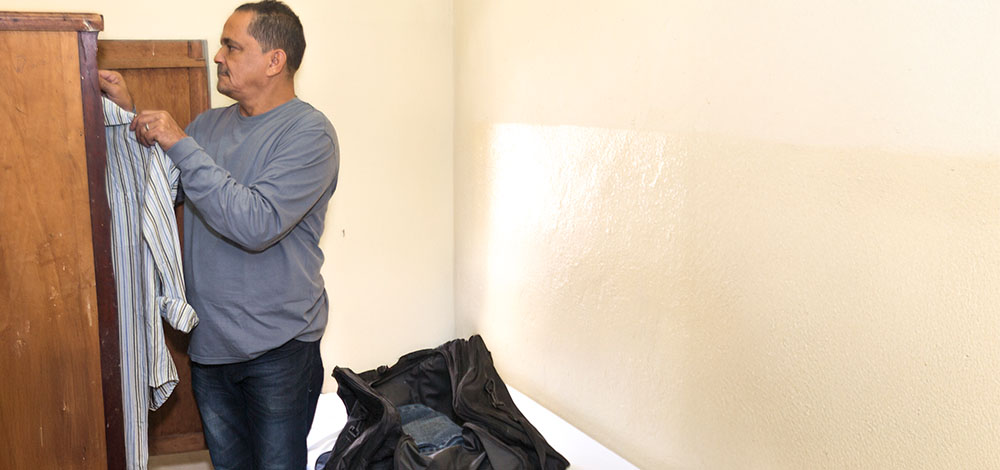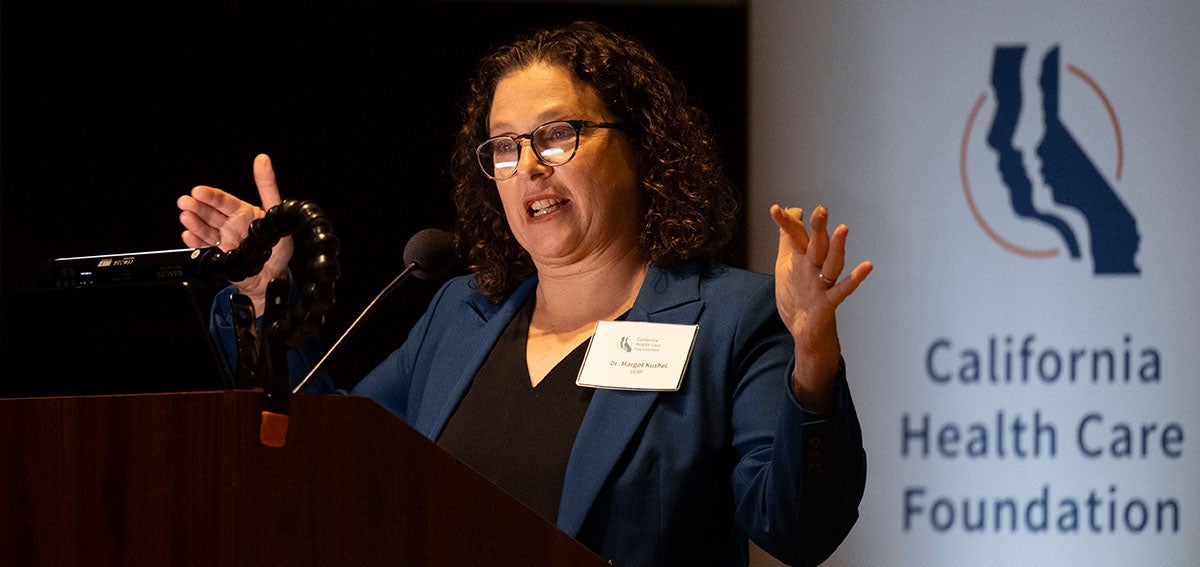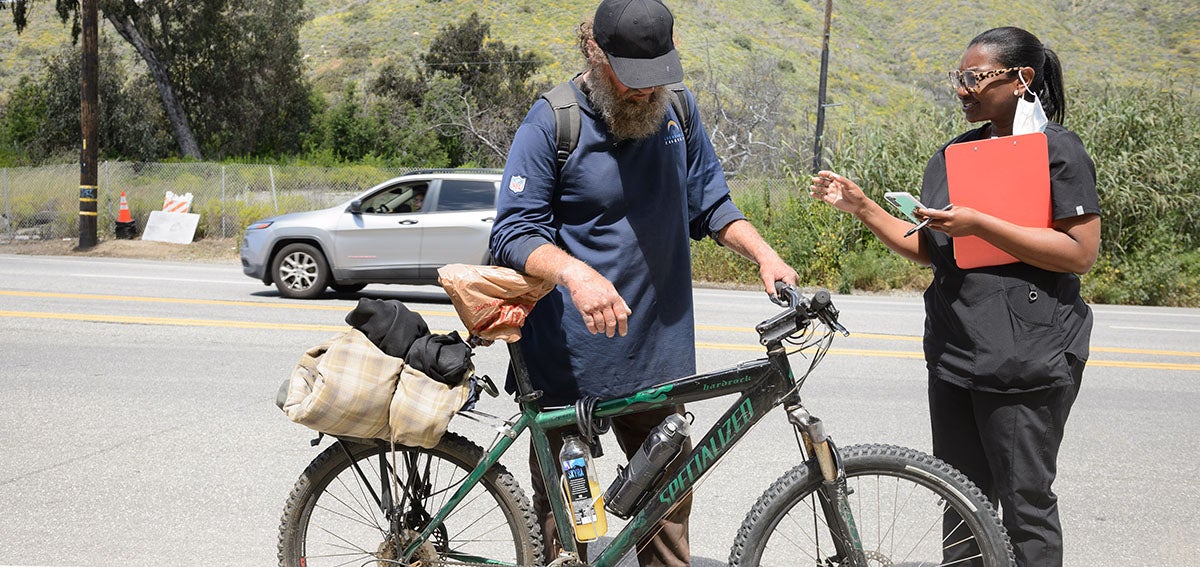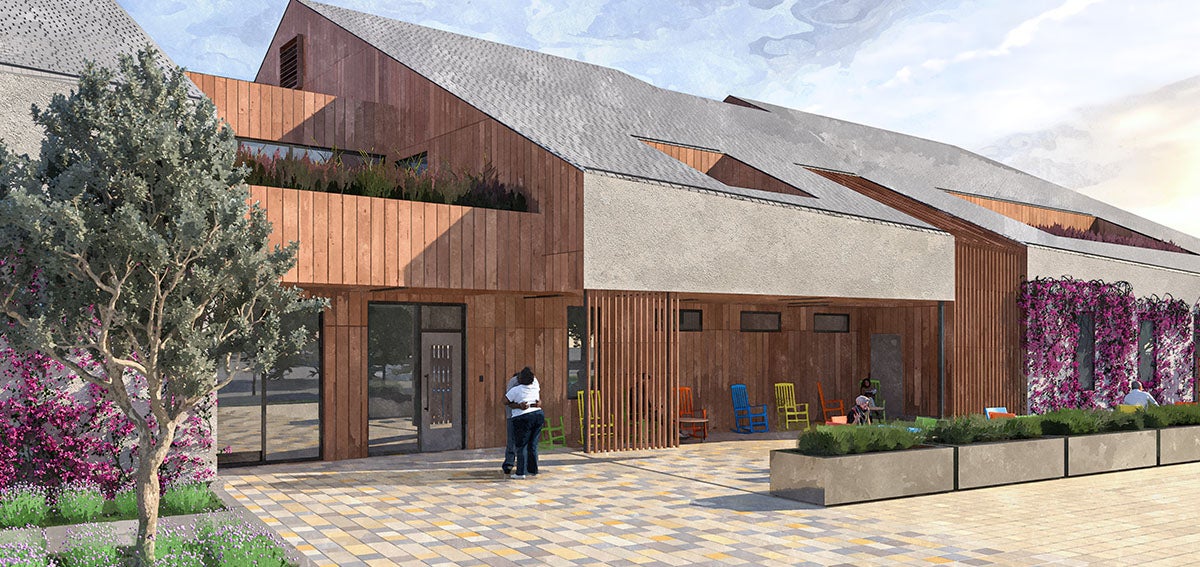
On May 5, 2017, longtime housing advocate Doug Biggs received an unforgettable email from officials with the city of Alameda. The site of a defunct federal food inspection facility was available for conversion into housing and services for people experiencing homelessness (PDF). Would his organization, the Alameda Point Collaborative, be interested in making it happen?
After the facility shut down around 2016, it was governed by a federal law requiring that the property could be conveyed at no cost to nonprofits, institutions, or governments through an extensive application process with the US Department of Health and Human Services. Eligible projects are required to operate the site for one of several categories of eligible use, including homelessness programs.
Biggs, a long-time Alameda resident and executive director of the collaborative, a supportive housing and services provider, was familiar with the site of the former US Department of Agriculture meat inspection laboratory. Built during World War II as a naval training facility, the 3.65-acre parcel has multimillion-dollar views of San Francisco Bay and the San Francisco skyline. A shoreline park and Crab Cove Beach are within a stone’s throw.
As head of the collaborative for close to two decades, Biggs knew he needed help to ensure the potential of this special place would be realized, so he began to assemble a team of nonprofits and advocates. It turned out to be a determined group.
“Most homeless programs are sited in industrial zones and harsher environments. This environment is naturally conducive to health restoration and healing.”
—Bonnie Wolf, project directoR
The opportunity presented to Biggs in that email has blossomed into concrete plans for the Alameda Wellness Campus, an integrated care center for homeless seniors and adults with complex health conditions. The campus has garnered support from State Senator Nancy Skinner, the Alameda County Board of Supervisors, Alameda Mayor Marilyn Ashcraft, and the city’s police and community paramedics. The collaborative overcame stiff neighborhood resistance, survived a special city election, and raised significant financial support — and construction is targeted to begin next summer.
Biggs brought in Bonnie Wolf, a consultant to nonprofit organizations, to act as the project’s visionary, collaboratively shape the project model, write the application to acquire the property, and assemble project advisers including community leaders, content experts, nonprofits, and consumers. Wolf said she took one look at the site’s sweeping bay views and knew the team had a rare opportunity to create a transformational project. This location could promote health recovery, housing stability, well-being, and dignified end-of-life care for people experiencing homelessness, she said.
“We realized we had an ideal opportunity to create a project that elevates the standard of care for unhoused people,” she said. “Most homeless programs are sited in industrial zones and harsher environments. This environment is naturally conducive to health restoration and healing.”
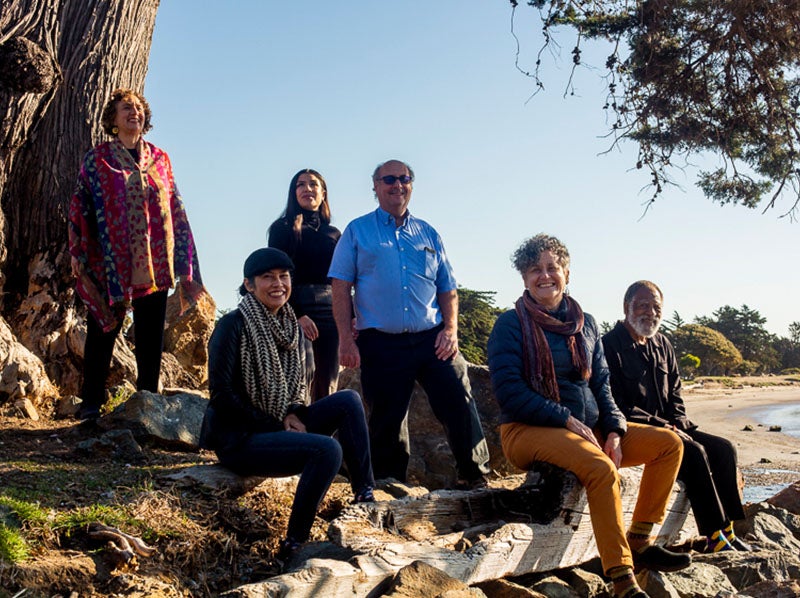
The Bay Area, like so many other parts of California, is reckoning with a major homelessness crisis and has come under fire for the horrid conditions unhoused people face.
Arnold Perkins, 80, was Alameda County’s first homeless coordinator 35 years ago. Later he was director of the Alameda County Health Department and today is a key and active supporter of the Wellness Campus. Over the decades, he witnessed untold suffering caused by homelessness and watched the number of unhoused people in Alameda County increase drastically, nearly doubling to 8,000 between 2015 and 2019 (PDF), with Black and older men overrepresented.
“Imagine someone being 80 years old and trying to live in a tent or under a tarp,” said Perkins. “It’s not right for society to treat its seniors that way.”
Perkins relates to the hardships unhoused seniors face every day on the streets, he said, because he knows that being 80 is hard even when you have a house. He remembers how things were after he underwent a double bypass heart surgery last summer. “If I would have been unsheltered and had to sleep in a tent, I probably would have died,” he said.
Supportive Housing for Seniors
From the get-go, the project aimed to address the gaps in services for unhoused older adults and those who are medically vulnerable. “People in their 50s often have medical conditions similar to folks in their 70s and 80s, and unhoused people die about 25 years earlier than housed individuals,” Wolf said. “African Americans are particularly slammed by homelessness in Alameda County and across the nation, representing 47% of the homeless population while comprising just 11% of the county’s population.” In addition, she said, “Homeless deaths have doubled in the past two years in Alameda County.”
Biggs and Wolf felt that the highest use for the campus setting was to combine health care, supportive housing for seniors, a medical respite center and end-of-life care to assist people experiencing homelessness while recuperating from surgery, medical procedures, and illnesses or who qualify for hospice-level care.
The organizers of this effort believe the care model used on the campus will be one of the first of its kind in the US. It will not resemble a typical downtown congregate shelter and instead will be a sprawling two-level minimalist-style structure with a natural wood exterior located in a scenic, tranquil setting.
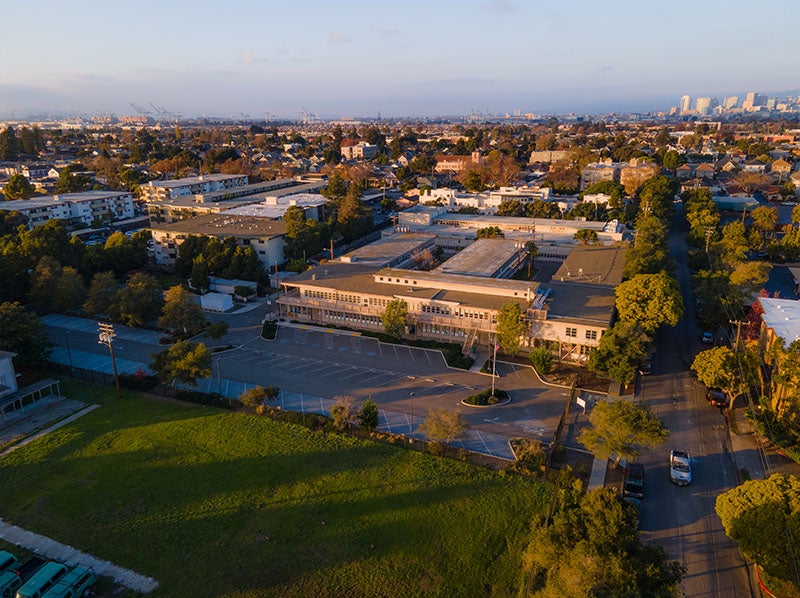
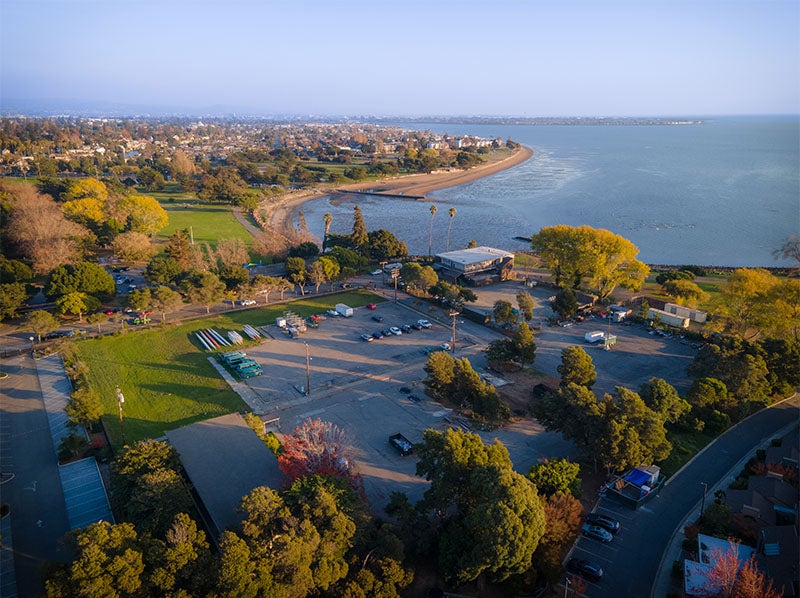
All the government structures on the property will be demolished and the campus rebuilt with state-of-the-art construction materials and designs tailored for unhoused people with complex medical conditions. The buildings will feature warm and inviting design, wheelchair accessibility, private rooms, and separate spaces for women. Evidence-based design can improve patient experiences, accelerate recuperation, and produce better outcomes, according to Ellen Fisher, vice president of academic affairs and dean of the New York School of Interior Design.
The Wellness Campus will serve 700 Alameda County residents annually with the following:
- 100 beds of supportive housing for unhoused seniors with case management, assistance with daily living, and access to medical, geriatric, and behavioral health services, and palliative and hospice care.
- A 50-bed medical respite center serving an estimated 400 unhoused adult county residents discharged from hospitals with no safe place to heal, identified through street outreach as needing care for acute conditions, or eligible for hospice care.
- A primary care clinic with integrated medical and behavioral health care.
- A homeless prevention and housing placement resource center for city of Alameda residents.
Construction on the first phase of the $100 million project is set to start in July 2022. The collaborative and LifeLong Medical Care are leading the capital campaign to build the medical respite center and clinic, and are pursuing the remaining $12 million of the $42.6 million cost. To date, they have received commitments for $15 million from the state, $10 million from Alameda County, and $2.5 million from Kaiser Permanente. The California Endowment recently invited the project to apply for a $3 million grant, Wolf said. Financing for the senior housing has been raised or identified with Mercy Housing and will be built as the second phase of the campus.
“Most medical respite centers are cobbled together and shoehorned into place,” said Michelle Schneidermann, MD, director of People-Centered Care at CHCF and an expert on respite care, who has advised the organizers over the years. “This program in Alameda, I think, is going to be the first in California purpose-built from the ground up.”
Stable Revenue Through CalAIM
With CalAIM — the state’s long-planned and extensive revamp of Medi-Cal — taking effect next year and creating new opportunities for Medi-Cal managed care plans to fund medical respite programs, many providers hope this stable source of revenue will allow them to shift their focus away from securing short-term grant funding and toward enhancing services and quality.
“My hope for this project is that it will become a model for how to deliver human-centered care in a healing natural and built environment,” Schneidermann said.
Early on, the East Bay–based Federally Qualified Health Center and social services provide LifeLong joined as a key project partner. Brenda Goldstein, MPH, chief of integrated services at LifeLong and Wolf shaped the integrated service model and conducted the substantial research for the project.
The project team aimed to create a healing environment with attractive buildings, garden courtyards, sitting areas, and a community garden. Working with architect team Ankrom Moisan and Mantle Landscape, Alameda Point Collaborative and LifeLong emphasized a trauma-informed approach to design, including a separate section for women to address the high level of sexual violence that unhoused women experience. The respite facility offers six private rooms for people with communicable diseases and those receiving hospice care.
Research shows that medical respite programs reduce hospital admissions, hospital lengths of stay, and rates of readmission within 30 days.
The respite center will care for unhoused people staying for an average of 45 days. They will have access to medical providers, case managers, and healthy meals, and they will be connected to resources for permanent housing and other housing navigation services. They also will be connected with primary care providers for quality, consistent, and preventive care.
Residents of both the housing and respite center will have access to the primary care clinic, mental health and substance use recovery services, and complementary therapies like acupuncture, art, cooking, music, and tai chi and qigong – centuries-old practices that involve certain postures and gentle movements with mental focus, breathing, and relaxation.
Time and Space to Heal and Connect to Services
Medical respite care emerged nationally in the 1980s. Today 100 respite programs operate in 29 states, and each takes a different approach to caring for patients. Some providers refer to it as medical respite, while others call it recuperative care. What they all share is their aim to create a space for people experiencing homelessness to safely recover from illness or surgery and to connect to social services.
Medical respite care gained a foothold in California about six years ago with the help of funding through Medi-Cal’s Whole Person Care pilot program, which allowed communities to test respite programs to address homelessness and related challenges. There isn’t a standard model of care, the facilities don’t need to be licensed, and communities stitch their programs together based on local assets and community priorities.
This year, the National Institute for Medical Respite Care and the Respite Care Providers Network released a standard of care framework for guiding respite providers. However, there is no mechanism to ensure standards are implemented.
Unhoused people with unmet physical and behavioral health needs often rely on hospital emergency rooms for their health care, resulting in poor health outcomes and many being discharged to shelters or back to the streets, where they are unable to recover. The problem was pervasive enough in California for the Legislature to pass a law that took effect in 2019 requiring hospitals to create a plan for safely discharging unhoused patients. Providers and advocates say it’s inhumane to discharge someone experiencing illness or recovering from surgery to the street.
Research shows that medical respite programs reduce hospital admissions, hospital lengths of stay, and rates of readmission within 30 days.
Medical respite provides the potential for unhoused people to reset their lives, particularly those who may have disengaged and are discouraged from accessing medical care, due to the legacy of health inequities and racial harm or mental health stigma, Wolf explained.
“The hope is that this center will offer a time and a space for people to heal,” Wolf said. “A window where we can engage people with compassionate and comprehensive services and help ignite new hope for their lives.”
Overcoming Neighborhood Opposition
The project has not had an easy path. While many community leaders and neighbors supported it, a small yet vocal neighborhood group, Friends of Crab Cove, formed to defeat the proposal.
The nonprofits and advocates defended the campus as one in which the city of Alameda would take pride and said it would not attract encampments. That concern ultimately persuaded them to stay focused on senior housing and respite care and not to offer shelter or childcare services that might generate foot traffic.
“The not in my backyard, or NIMBYism, that these kinds of projects face is pretty consistent across every community in the Bay Area.”
—Tomiquia Moss, CEO of All Home
The Friends of Crab Cove nonetheless collected enough signatures to put an initiative on the ballot for city voters to rezone the property so the project would be killed, and the group sued to block the housing project.
Biggs remembered that in the 1970s, the city restricted new multifamily housing, and several years ago, a community group blocked an affordable housing proposal on a nearby parcel of federal land. “There was this fear that, ‘Oh, you’re going to bring the encampments to our streets,’ and people just couldn’t get past that,” Biggs said.
The opposition group campaigned in front of the development site wearing crab costumes and holding signs comparing future patients at the facility to unwelcome creatures invading the neighborhood.
It’s common for communities to fear that unhoused people will ruin their neighborhoods, says Tomiquia Moss, an adviser to the Wellness Campus and CEO of All Home, a nonprofit assistance provider to low-income and unhoused people.
“One of our challenges in addressing homelessness across the region is that people typically oppose these types of projects but also are frustrated with the homelessness crisis,” Moss said. “The not in my backyard, or NIMBYism, that these kinds of projects face is pretty consistent across every community in the Bay Area.” Moss views the Wellness Campus as a transformational project for our region.
To counter the neighborhood opposition, the Wellness Campus organizers sponsored their own ballot initiative, leaving the decision in the hands of the voters. In a special election, city of Alameda voters in April 2019 rejected the Friends of Crab Cove initiative and enabled the senior housing and medical respite project to go forward and serve the county as a whole. It wasn’t a landslide, but it showed that more affluent Bay Area residents will support affordable, supportive housing and health resources for people experiencing homelessness.
The supporters also prevailed in the litigation. There is still funding to be raised and more steps must occur in the conveyance process before supporters can realize their dream.
Circle of Support
Goldstein vividly remembers first meeting Biggs, Wolf, and others at a picnic table in the nearby bayfront park. It was a tranquil setting – and much closer to the beach than she had imagined. The sea air was refreshing, and the views of the water and San Francisco across the bay were awe-inspiring. “It’s a place we would all want to live and would want our loved ones to live,” she said.
Wolf said she is optimistic about the project’s future. “A beautiful circle of support has shaped the project and enabled a new model of hope and healing for our communities,” she said.
Authors & Contributors
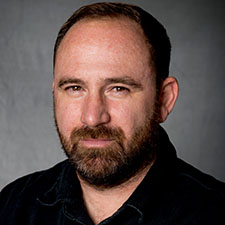
Brian Rinker
Brian Rinker is a freelance writer and journalist. He covers digital health, public health, child welfare, start-ups, and venture capital. His work has been published by Kaiser Health News, Health Affairs, The Atlantic, Men’s Health, and San Francisco Business Times. Brian received master’s degrees in journalism and public health from UC Berkeley.

Subha Joshi
Subha Joshi is a photographer based in Oakland and the East Bay area. She is fond of nature in its native form — Earth without makeup. Many of Subha’s photographs reflect her love for landscapes, sunsets, sunrises, and wildlife. Her photography drives her to seek out the beauty in everything.

Colleen Cummins
Colleen Cummins is a visual journalist based in Oakland. She was named 1 of 28 talented urban photographers to follow on Instagram by Buzzfeed. She is a founding member of @Everyday.California as well as part of Women Photograph.

